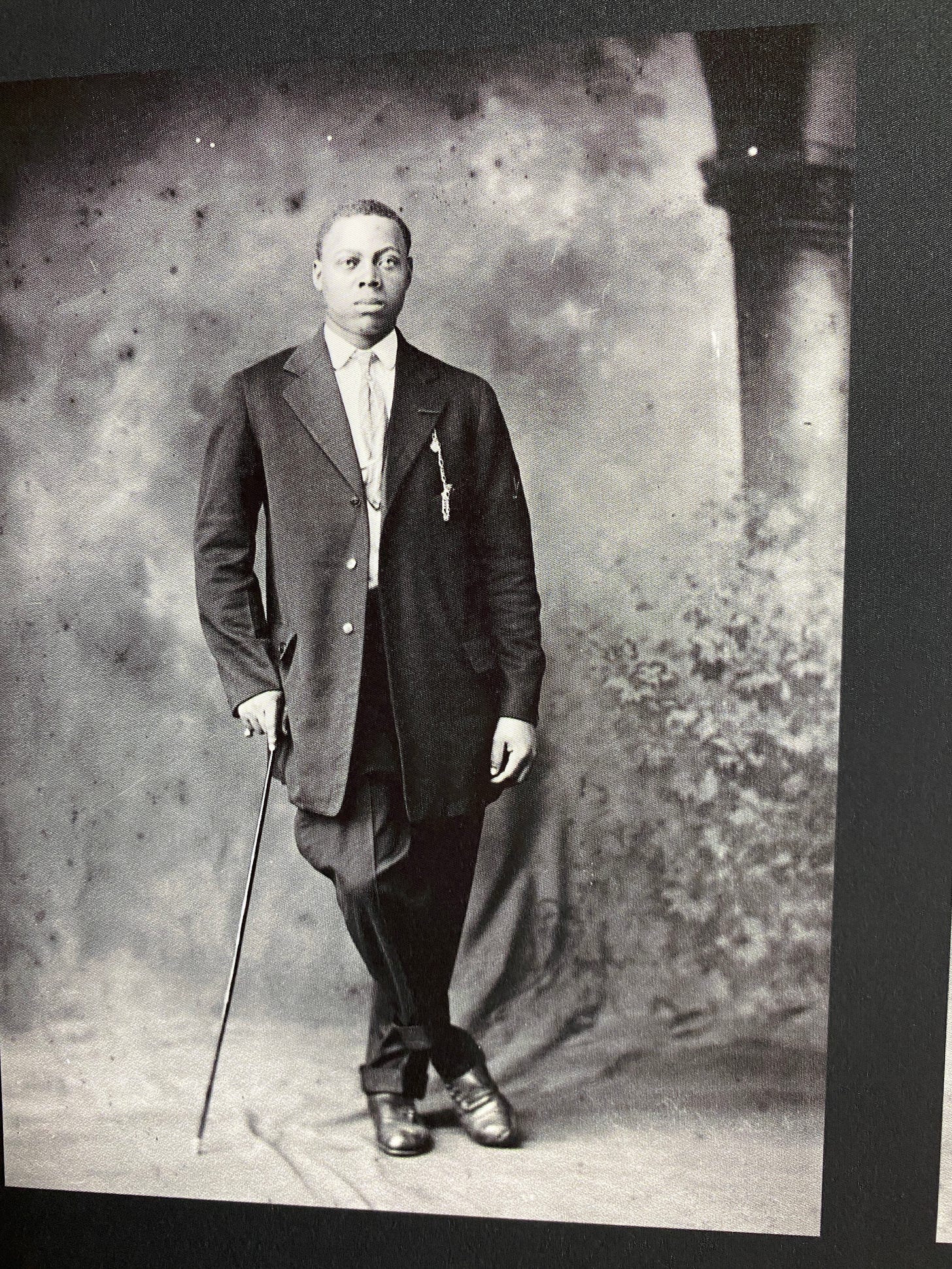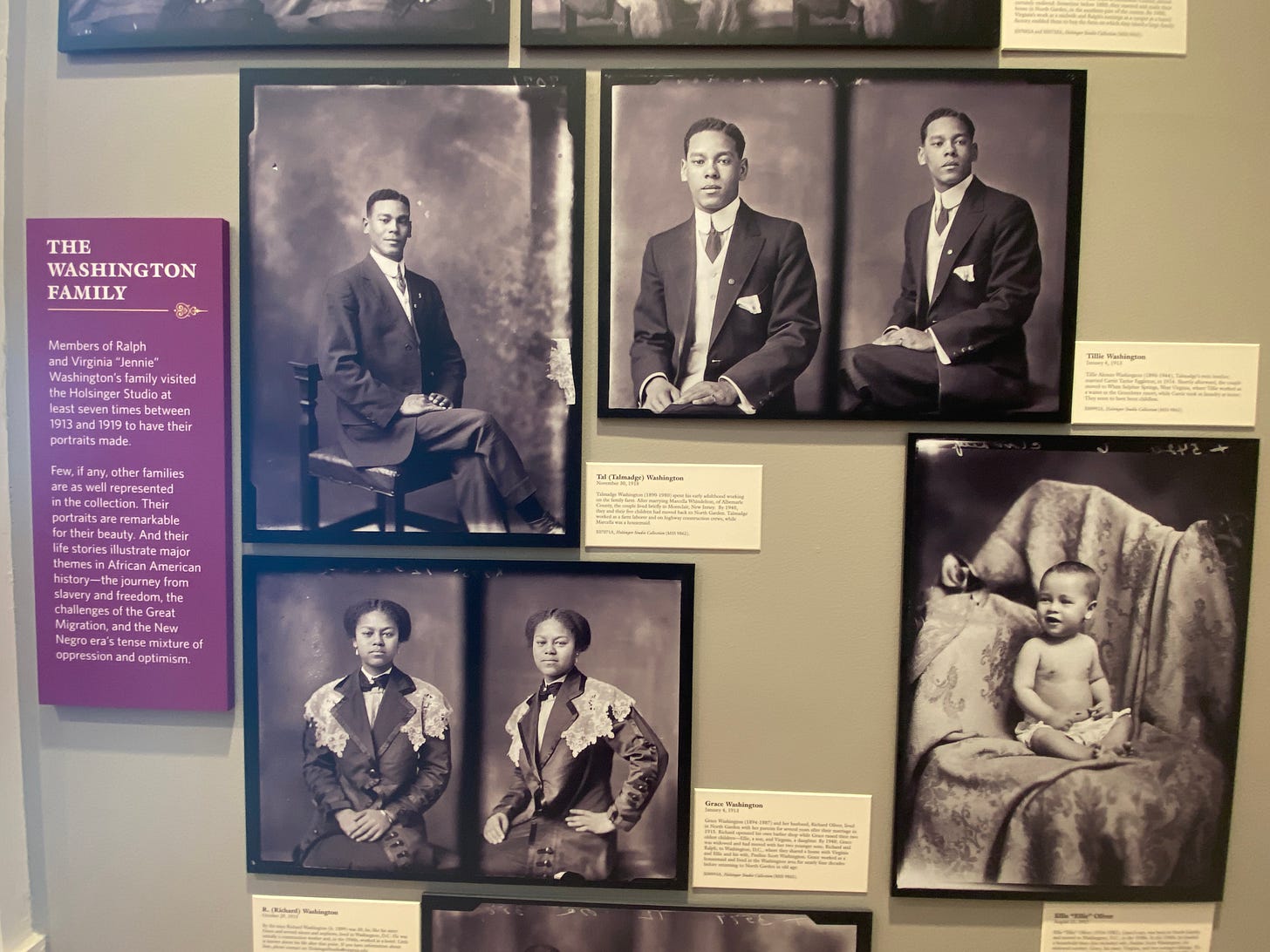Holsinger Photo Exhibit @UVA of Black Virginians in the Early 1900s Debuts
CHARLOTTESVILLE, VA — 📷 On September 22, the photo exhibit VISIONS OF PROGRESS, Portraits of Dignity, Style and Racial Uplift launched at the University of Virginia and it is glorious!
The photography that makes up Visions of Progress will remain on display at UVA until June of 2023 at the Main Gallery of the Harrison Institute and Small Special Collections Library, University of Virginia located at 170 McCormick Road, Charlottesville, VA 22904.
The photos, taken during the glass plate era of photography in the early 1900s, showcases Black community leaders, business leaders and residents from central Virginia — mostly from Albemarle County. The photographer, a white man named Rufus Holsinger (1866-1930), owned a studio in Charlottesville that made the images.
The project to formally display the images at a large exhibition in a gallery was seven years in the making and preceded by smaller showings and events around Charlottesville.
The images reflect Blacks at a time when most works of photography ignored their presence or reflected Black individuals poorly — if at all. There were many individuals who worked on the Holsinger portrait project. Though many were involved in putting together the portrait project, the main driver of the effort was UVA Associate History Professor John Edwin Mason, the chief curator of the project.
Mason thanked an endless number of people who assisted with the project. Photography projects require a great deal of research, printing, context and planning before anything is positioned on the wall. Below is a list of the curators of the project.
“This is not the culmination, but this is a milestone in the life of the Holsinger studio portrait project. It's something that came together seven years ago, moving towards a moment where we can have a public exhibition like this where we could bring these portraits to the public to both enjoy us for their beauty, but also to use them as a way of seeing history. It's a really important moment,” Mason said to about 50 onlookers standing in the gallery during its Sept. 22nd opening.
Black Virginia News is in an endless search to find the most Blackity-Black news and events in Virginia. This exhibit will likely be in our top ten when we look back at 2022.
👊🏽 Professor Mason said so much more on the project and the meaning behind the images, which is cataloged below.
👊🏽 “This is not the culmination, but this is a milestone in the life of the Holsinger studio. Project Project. It's something that came together seven years ago, moving towards a moment where we can have a public exhibition like this where we could bring these portraits to the public to both enjoy us for their beauty, but also to use them as a way of seeing history. It's a really important moment.” — Prof. John Edwin Mason
👊🏽 “Let me start by acknowledging the work of my late colleague, Reginald Butler, Professor in the History Department. He was also director of the Watson Institute, and Scott French, who was the Associate Director of the Woodstock French and is now at the University of Central Florida. They were the pioneers in the scholarly study of black history in central Virginia. And they mounted an exhibition in 1999 of these halls that are portraits have the votes, that you have gotten much more attention than they do. But we stand on the shoulders of Reginald Butler and Scott French.” — Prof. John Edwin Mason
👊🏽 “None of this would have been possible without the support of the Albert and Shirley Small Special Collections Library and they came to the Holsinger Portrait Project and they said, we've got something for you. We have a room. We have enough money to print the portraits.” — Prof. John Edwin Mason
👊🏽 “We know it's hard to get here. There's a practical reason. We also recognize that there's laboring skepticism within the African American community about the University of Virginia, and sometimes a reluctance to come here. Well, we want to take the exhibition to people. We're going to have traveling exhibitions. We're going to have catalogs and brochures. We are having the elaborate website there'll be a variety of different ways in which we take this exhibition off grounds and into the world.” — Prof. John Edwin Mason
👊🏽 On the images impact on the Charlottesville and Central Virginia community: “They’re connecting us with descendants of the people that you see in these portraits and there's plenty of descendants in Charlottesville and to meet somebody who has a grandmother, a great aunt, a great great uncle in the portraits is it's a incredibly moving experience.” — Prof. John Edwin Mason
👊🏽 On the subjects’ connection to Albemarle: “Let me tell you, they mostly did not live in Charlottesville. This is something that's really important to know about the people in the portraits here. They're mostly from Albemarle more so than Charlottesville. And they're quite a few from Nelson County. So this really is about Central Virginia.” — Prof. John Edwin Mason
👊🏽 Andrea Douglas Shoutout. “Thank you to Andrea Douglas at the Jefferson School African American Heritage Center in Georgia Jaeger down there. I'll use another cliche. It's really taking a village, it takes a team. It takes a lot of people to make something like this happen, and then to continue the project in its ongoing life. — Prof. John Edwin Mason
👊🏽 Changing How We See Black History. “We have a very modest goal. We want to transform the way that everybody in central Virginia sees our history because we want to reach everybody in central Virginia and we want to utterly transform the way they see. And I mean that in two senses. I mean it literally that when people imagine what black folks look like during the height of the Jim Crow era, they do not imagine for us. They don't imagine Lena Taylor. They don't imagine Fayette Johnson. They don't imagine Henry Martin looking like this. If you know anything about Henry Martin you think oh, well, he was a ol timey negro. No, he was not.” — Prof. John Edwin Mason
👊🏽 Yes, there's a portrait that Henry Martin himself commission from the Halsey her studio. And look at that portrait. That portrait has nothing to do with him. Has nothing to do with his job as a janitor. Well, it has a lot to do with the fact that he was a deacon at First Baptist Church on West Main Street. But this is, you know, this is an exhibition of self representation. — Prof. John Edwin Mason
👊🏽 “This is an exhibition of African Americans going to the studio. Yes, it was owned by a white man. Yes, the photographers down there they were all white but they were also interested in green. And so black people knew that you could go to the studio and have a portrait made that please you have portrait may have the way you saw yourself a portrait that would express who you are and who you dream to be and who you aspire to be. You know, these portraits are African Americans seizing the opportunity to tell stories about themselves. They are overwhelmingly working class people. This is not the black middle class.” — Prof. John Edwin Mason
👊🏽 “Jim Crow was missing in a couple of different ways. You look at these portraits, and you don't see any Jim Crow, you don't see the oppression and you don't see their status as second class citizens. You don't see their occupations as clerks and as janitors. But we're also not showing you the caricatures. We're not showing you the demeaning stereotypes that were floating around in African American and American visual culture, the demeaning stereotypes that were part and parcel of white supremacy. We're not showing you that.” — Prof. John Edwin Mason
“But everybody in these pictures knew about them. They saw them on a daily basis. They were published in newspapers, they were published in magazines, they were part of movies like Birth of a Nation, which showed several times and Charles. So Black folks knew how white folks saw them. And what these portraits are as a way of saying, No, that's not who we are. Let us show you who we are. You know, they are a form of resistance to white supremacy and racism. They're silent. And mostly they were private.” — Prof. John Edwin Mason
🍁 Press releases, tips, pitches? Please write us at BlackVirginiaNews@gmail.com





















